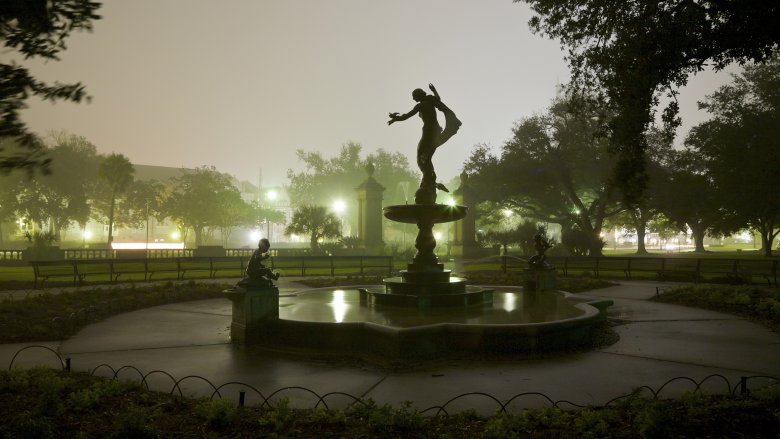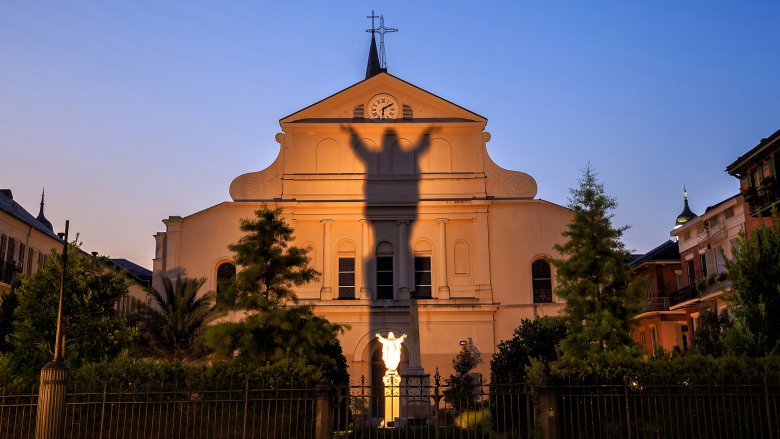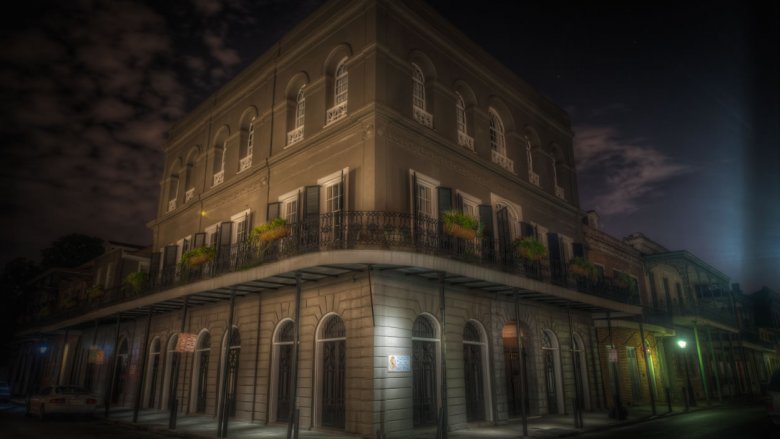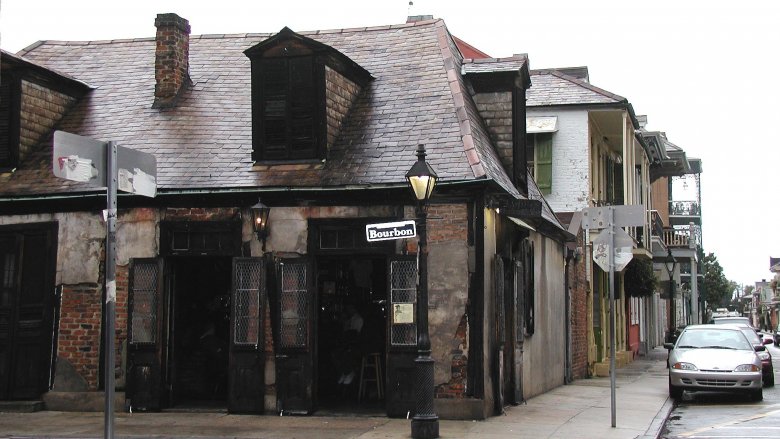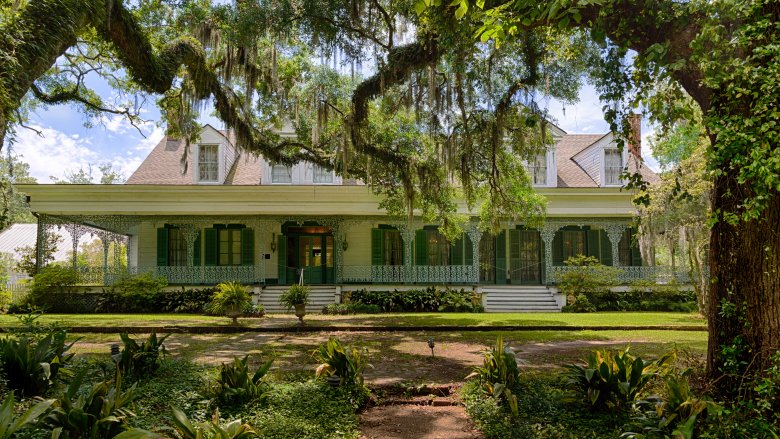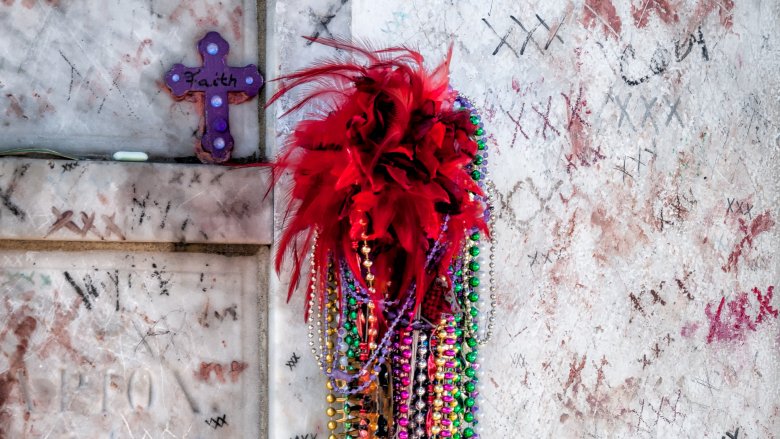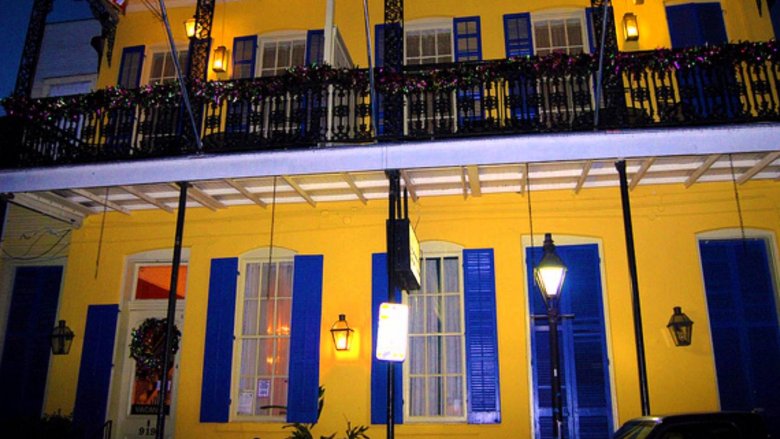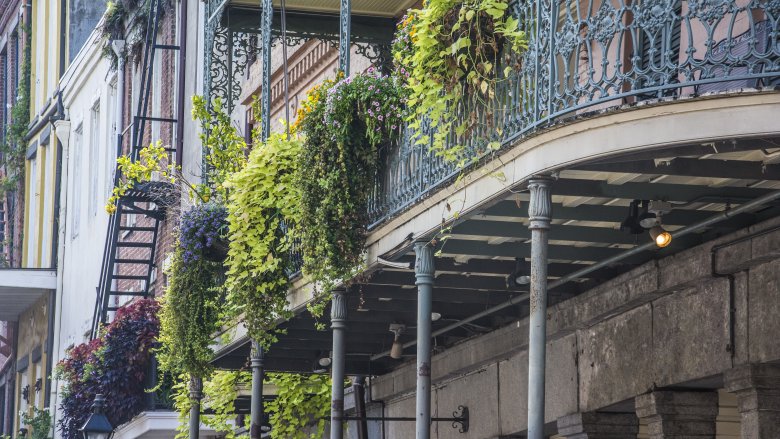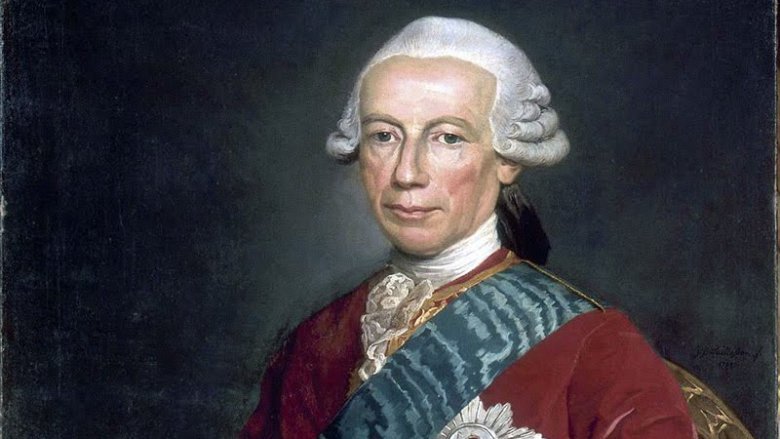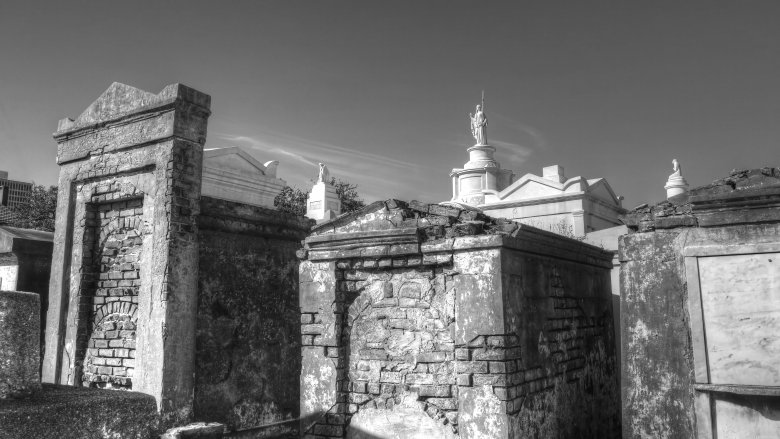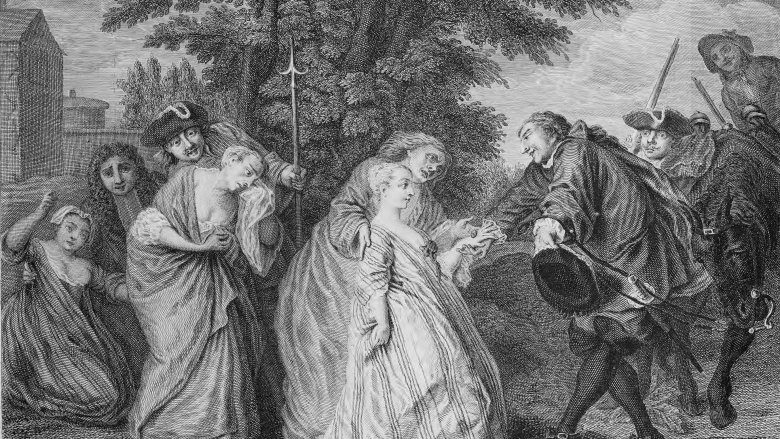Messed Up Things That May Have Happened In New Orleans History
New Orleans! Home of pirates, drunks, and whores! New Orleans! Tacky overpriced souvenir stores! So sang The Simpsons in an episode that they apologized for shortly after via chalkboard gag. In reality, New Orleans, which celebrated its 300th anniversary in 2018, is a cultural center of the United States, famous for its music, cuisine, and wild and ornate parades and festivals. It has a long and storied history full of colorful figures who helped contribute to its character. Many of them, to be fair, were pirates, drunks, and whores.
If you go to New Orleans, there are a number of things you're likely to see: palm trees, pelicans, potholes, street musicians, voodoo shops, and lots and lots of other tourists. And if the many available haunted history tours available throughout the French Quarter and various cemeteries are to be believed, you might also see a ghost or vampire lurching down Bourbon Street. While every city of a certain size has its share of spooky legends, the Big Easy seems almost to have an overabundance.
The Singing Rain of Pirates Alley
One of the most famous landmarks in New Orleans' French Quarter is the St. Louis Cathedral, the oldest cathedral in the United States, which faces Jackson Square and features a strikingly Dracula-esque statue of Jesus. The alley that runs next to it, known as Pirates Alley, is also home to one of the most famous ghostly phenomena in all of New Orleans.
First a little history: Louisiana was a French colony from 1718 until 1763 when the French ceded the territory to Spain as part of the Treaty of Paris following the Seven Years' War. The French colonists of New Orleans were not stoked at this state of affairs and — long story short — a rebellion led by French colonists was put down by an Irish expatriate loyal to Spain known as Bloody O'Reilly, who had the rebel leaders publicly executed on a street still known today as Frenchmen Street, now a popular spot for music.
That's all very true history. Where legend picks up is in the story that says that the bodies of these Frenchmen were hung out to rot by the cathedral, and the priest, Pere Dagobert, was forbidden to bury them until the Spanish guards, unused to New Orleans weather, took shelter during a hurricane and the priest was able to transport the bodies of the dead to St. Louis Cemetery No. 1. And legend says that even today when it rains, you can hear Pere Dagobert singing the Kyrie (presumably the hymn and not the pop hit by Mr. Mister) down Pirates Alley.
The LaLaurie torture mansion
One of the most famous haunted houses in New Orleans — so famous that many just call it "the Haunted House" — is the LaLaurie Mansion at 1140 Royal Street in the French Quarter. It might be famous because it featured heavily in Season 3 of American Horror Story, or maybe because Nicolas Cage owned it for a little while for some reason. But really, it's famous because, as Ghost City Tours points out, legend says some really messed up stuff happened in there.
Dr. Louis LaLaurie and his wife, Delphine, moved into the mansion in 1832, and Delphine, a proud socialite, soon gained a reputation for being cruel to her slaves, especially after she was seen chasing a young slave girl off a balcony to her death with a bullwhip after accidentally pulling Delphine's hair. But it was an 1834 fire that revealed the true horror of the LaLaurie Mansion.
A slave chained to the stove had set the fire because she would rather die than be taken to the room upstairs. Firefighters who entered this room discovered it was full of more than a dozen slaves who had been chained, caged, tortured, and experimented on. Later (spurious) legends say one victim had been caged with her bones broken and reset so she could only walk like a crab, and others had holes drilled in their heads. Delphine LaLaurie, now uncovered, fled to France and little is known about what happened to her afterward. Anyway, the house is haunted now, obviously.
The pirate ghost of Jean Lafitte
Pirates have been so romanticized by movies and books that it's almost hard to remember that they were real people who committed real crimes, often under the auspices of real governments. One of the most famous pirates in U.S. history — and certainly the most famous in New Orleans — is Jean Lafitte, who traded in infamy for legitimate fame when he helped Andrew Jackson fight the bloody British in the Battle of New Orleans.
Lafitte owned a business in the French Quarter in the early 19th century that is one of the oldest surviving structures in New Orleans, and, at least according to its website, the oldest continuously operating bar in the United States. It probably wasn't a bar when Lafitte owned it, though. It was, uh, maybe a blacksmith shop, so it's known today as Lafitte's Blacksmith Shop. They serve a grape-flavored voodoo daiquiri that tastes like purple cold medicine. Oh! Also it's haunted.
According to legend, a full-body apparition of Lafitte is a common guest at the bar who bears his name and he, a notorious womanizer, has been reported to unhook a bra strap or two in the women's restroom. On the second floor there's alleged to be the ghost of a woman who will whisper your name into your ear, and piercing red demonic eyes appear regularly in the bar that fade into darkness after you make eye contact with them. It might be worth risking a demon for those daiquiris, though.
The many ghosts of the Myrtles Plantation
Okay, technically, St. Francisville, Louisiana, is about 100 miles outside New Orleans, but its most famous haunted house, the Myrtles Plantation, is so haunted that its ghostly aura stretches across the mere hour and a half drive like it's nothing.
According to the stories you might hear at Myrtles, the site is home to as many as 12 ghosts and the location of 10 different murders. Basically none of that is true and there's only one confirmed murder at Myrtles, but, hey, this ghost stuff is all in fun, so enjoy!
The most famous ghost at Myrtles is known as Chloe, and according to incredibly spurious legend, Chloe was a slave girl forced into a relationship with her owner, Clark Woodruff. When Woodruff caught her listening at keyholes to his business dealings, he had one of Chloe's ears cut off as punishment, and she covered the subsequent scar with a green turban. As revenge, Chloe then poisoned Woodruff's wife and children with a birthday cake containing oleander leaves (this was the poison part). She was hanged and now people see a green, turban-wearing ghost all over the place. It turns out the Woodruffs actually owned zero slaves, but cool story.
Additionally, the ghost of the one person actually murdered there is said to stagger up the stairs he died on, and a particular mirror is said to contain the spirits of Mrs. Woodruff and her children, trapped there after their bad cake experience, among many other tales.
The haunted tomb of the Voodoo Queen
Thanks to her prominent appearances in pop culture such as a 1974 hit song, Marvel Comics, and, yeah, American Horror Story, there is probably no name more associated with voodoo than Marie Laveau. Laveau was a real person, who, together with her daughter (who was also named Marie Laveau and who may have assumed her mother's identity after her death, making their histories hard to disentangle) amassed thousands of followers to their uniquely New Orleans brand of spiritualism in the 19th century.
In life, according to Ghost City Tours, Laveau became the Voodoo Queen of Congo Square, leading people in chants and selling charms with a boa constrictor named Zombi draped over her shoulders. It's only natural, then, that people would continue to seek her aid more than a century after her death.
While of course her house is haunted, the most famous haunted location associated with Laveau is her tomb at St. Louis Cemetery No. 1. Many people will leave offerings at her tomb and seek her blessing by drawing an X on the tomb, or some other series of rituals, which will lead her to grant your wish. Don't actually write on the tomb, though, because that is actually super-illegal.
You know what else is super-illegal? Breaking into a cemetery to see her body. That's what history's spookiest punk band the Misfits did on Halloween 1982, for which they were totally arrested. The best part? They weren't even at the right cemetery: They went to St. Louis Cemetery No. 2.
The haunted hotel that rose from the ashes of an orphanage
To paraphrase Oscar Wilde, to have your city destroyed by one fire may be regarded as misfortune; to have it destroyed by fire twice looks like carelessness. It turns out that the reason most of the buildings in New Orleans' French Quarter are actually Spanish and not French is that the city was destroyed by fire in 1788 and again in 1794. A notable survivor of both blazes is Lafitte's Blacksmith Shop; the story goes that the people formed a bucket brigade to save their favorite bar, but in reality it was probably saved by its slate roofing.
One building that wasn't so lucky was the site that now houses the Andrew Jackson Hotel. According to the hotel's website, the hotel was originally built as a home for boys who lost their parents to a yellow fever epidemic in the late 18th century. If it weren't bad enough that these boys were orphaned, they also died in a fire. Wilde might call that carelessness, too, to be honest. Now the hotel that was built in that location is said to be haunted by the ghosts of the five boys who died in the fire.
The boys' giggling can be heard in the courtyard, and they're known to push people out of bed or snatch their pillows out from under them. Other stories report that they like to change the channel on the TVs or pour cereal on the ground. Boys, it seems, will be boys, even when long dead.
The ghost of the hanging Romeo
If you look closely at the architecture when you wander around the French Quarter, you might notice an interesting detail: Most of the columns under the numerous balconies in the Quarter feature curly, spiky, or otherwise pointy ornamentation sticking out from the poles most of the way up. These pointy bits are called Romeo spikes, or Romeo catchers, and their name hints at their function: They're meant to keep you from climbing up the column and getting frisky with the homeowner's daughter (or wife, or son, or whoever).
One famous New Orleans ghost story relates the tale of a young man who ended up on the wrong end of a Romeo catcher. The story goes that a young woman was left alone by her parents as they went out for a night on the town, saying she was too ill to join them. As soon as her parents were gone, however, her boyfriend showed up, glad for the time alone. The bad news is that the girl's father had forgotten something at the house and unexpectedly returned. The boy tried to make a quick escape over the balcony, only to get his hip caught on the Romeo catcher.
The father fired a gun into the air to scare the boy, which caused him to let go, and the Romeo catcher ripped him from stem to stern, stringing out his intestines like streamers at Vlad the Impaler's birthday party. This gutsy ghost can still be found hanging around the French Quarter, so to speak.
A vampire in the French Quarter
The Crescent City isn't just famous for ghosts, even though it's got them by the swamp-boat-load. It's also got hella vampires, and not just Brad Pitt and Tom Cruise. Perhaps the most famous New Orleans vampire is Jacques St. Germain, who may or may not have also been an immortal alchemist and philosopher.
Okay, so according to legend, in the early 1900s a guy named Jacques St. Germain shows up in the French Quarter and starts throwing money around in lavish dinner parties, though he is never seen eating at them. He regales his guests with incredibly detailed stories from all over the world that had taken place hundreds of years before as if he had witnessed them firsthand. People soon noticed his resemblance to the Count de St. Germain, a European adventurer and philosopher of the 1700s.
It must be absolutely stressed that the Count de St. Germain was a 100 percent real person who knew King Louis XV, Voltaire, Casanova, and other famous historical people. His life was also so mysterious that even in his lifetime people thought he was an immortal alchemist.
So what makes Jacques St. Germain a vampire and not just an immortal? His more, shall we say, sanguine proclivities were revealed when one day a prostitute leaped from his balcony to escape him after he began biting her neck. When police went to question St. Germain, he had disappeared, but they say Vampire Jack still lurks the French Quarter to this day.
Two vampire brothers
You might know that the cemeteries in New Orleans use above-ground vaults rather than burying their dead. This is partly because of the fact that the low altitude of the city means its water tables are high and flooding could cause bodies to float up out of the ground, and partly because the French and Spanish also used above-ground vaults. What you may not know is that in order to fit entire families into these tombs, old coffins are removed after a year or two to make room for new ones, with the remains placed back into the tomb sans box. Hold on to that fact; you'll need it in a minute.
According to legend, John and Wayne Carter were brothers who popped up in New Orleans during the Great Depression and worked at the docks. In 1932, an 11-year-old girl escaped their apartment in the French Quarter and fled to the police. Her wrists had been slashed, and she said the brothers had been feeding on her. When the police entered the apartment, they found 4 other people bound up and bleeding, and many others already dead. It took eight men to restrain the Carter brothers when they returned home. They were put to the death, and when their tomb was opened to retrieve their coffins a year later, their bodies were gone.
Their surviving victims didn't turn out great, either: One man went on to allegedly murder 442 people and dissolve their bodies in acid. Yikes.
The Casket Girls
First the truth: The so-called "Casket Girls" were young women sent from France to the French colony of Louisiana in 1728 to provide wives for the disproportionately male colony. The "caskets" they carried were just luggage trunks that had their clothes in them. The truth is fine, but, ahhhh, the legend.
The legend starts the same: Pale young girls arrived in New Orleans by boat, shyly clutching the caskets they carried with them. Their skin was so pale that they instantly blistered in the hot Louisiana sun. They carried their caskets to the Ursuline convent that was to be their home until they were married. However, things did not turn out well for the Casket Girls. The men of New Orleans rejected the pale girls, and many of them were forced to turn to prostitution. The French king, enraged by the failure of his policy, demanded the return of the girls.
The nuns went up to the third floor only to find that the caskets that allegedly held all the girls' belongings were actually completely empty. (The implication, you see, is that the girls were sleeping in the coffins instead of keeping clothes in there. The girls were vampires. That's the punchline.) The third floor of the convent was then sealed up and nailed shut with nails blessed by the Pope himself. This has not, however, completely kept the girls from feasting on blood from time to time. A very attractive, if completely bogus, legend.
